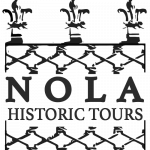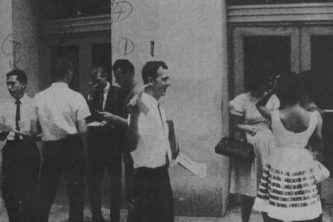PRIVATE JFK ASSASSINATION CONSPIRACY TOUR
J.F.K. ASSASSINATION CONSPIRACY: THE NEW ORLEANS CONNECTION
The Newman Building housed two addresses, 544 Camp Street and 531 Lafayette Street, a fact which informed District Attorney Jim Garrison’s conspiracy theory. On August 9, 1963, Lee Harvey Oswald was seen passing out Fair Play For Cuba Committee leaflets, which prompted anti-Castro Cuban activist Carlos Bringuier to accost Oswald; they were both arrested for disturbing the peace. Oswald’s leaflets bore the address 544 Camp Street, which was the former workplace of Carlos Bringuier when he served on the CIA-backed Cuban Revolutionary Council. Around the corner from 544 Camp, in the same building, was the address 531 Lafayette Street which housed the private detective agency of Guy Banister, anti-Castro activist, accused JFK assassination conspirator, and associate of Sergio Aracha Smith, official delegate for the New Orleans C.R.C. chapter. Witnesses claim Lee Oswald worked for Bannister in 1963 at his 531 Lafayette Street office. The origins of Garrison’s case can be traced to an argument between Bannister and investigator Jack Martin on the day of the assassination after they drank together at the Katzenjammer Bar, next door to 544 Camp Street. They returned to Banister’s office where they got into a dispute. Banister pistol-whipped Martin with his .357 Magnum and Martin yelled: “What are you going to do – kill me like you all did Kennedy?” Martin subsequently linked Bannister to the conspiracy, accused Bannister-associate David Ferrie of being the planned getaway pilot for the assassins, and tied Oswald to Ferrie.
Oswald had Mob ties in New Orleans through his uncle Charles “Dutz” Murret, who was a bookie for gambling kingpin and Carlos Marcello sidekick Sam Saia. According to House Select Committee on Assassinations Chief Counsel G. Robert Blakey, in 1963 when Oswald was living in New Orleans, he worked for Saia as a runner at Felix’s Oyster House, one of Saia’s French Quarter bookmaking parlors. Joseph Hauser, a witness in Carlos Marcello’s federal criminal investigation, reconstructed a statement of Marcello’s:
“Oswald? I used to know his [expletive] family. His uncle he work for me. The kid work for me to. He worked for Sam outta his place downtown … The feds came … askin’ about him, but my people didn’t tell ’em nothing.’ Like we never heard of the guy…”
Restaurant where D.A. Jim Garrison took his law school friend Dean Andrews to lunch and over Crabmeat Louie confronted Andrews about admitting to the Warren Commission that on the day after the assassination Andrews was called and asked to be Oswald’s lawyer and that the caller’s name was Clay Bertrand. Andrews replied that he’d never met Clay Bertrand. Garrison then threatened to call Andrews in front of the Grand Jury and charge him with perjury if he lies, to which Andrews replied, “If I answer that question you keep asking me, if I give you that name you keep trying to get, then it’s goodbye Dean Andrews…. like a bullet in my head.”
Burlesque Club run for years by Carlos Marcello associate Frank Caracci. In ‘Me and Lee,’ Judith Vary Baker writes that Jack Ruby took her there with David Ferrie and Lee Oswald. Carlos Marcello arrived later separately, as did Clay Shaw with Hugh Ward, pilot and Guy Bannister’s partner. In that same summer of 1963, Jack Ruby traveled to New Orleans to hire Bourbon Street dancer Janet Conforto, a.k.a. “Jada” fromThe 500 Club. Jada appeared in the Warren Commission Report but later they “couldn’t find her” for questioning, though two months later she was featured in a Pittsburg Press article.
Jim Garrison claimed that in late 1966 at the very beginning of his investigation, at “Cosimo’s, a small, crowded tavern deep in the Quarter… we had our first break.” Cosimo’s was the bar where Dean Andrews told the Warren Commission’s Wesley Liebeler he believed he’d once seen “Bertrand.” Garrison claimed the bartender “could not understand what the mystery was” about “Bertrand” — that as “far as he was concerned, everyone in that part of the Quarter knew Bertrand.”
Home where Clay Shaw was arrested on March 1, 1967. In the carriage house investigators found whips, lengths of chain, a black hood and matching black cape. During Shaw’s booking, Police Officer Aloysius Habighorst asked Shaw for his aliases and Shaw replied, “Clay Bertrand.”
In 1979, the House Select Committee on Assassinations concluded that John F. Kennedy was probably assassinated as a result of a conspiracy. A majority of Americans believe that JFK was slain as part of a conspiracy and refuse to accept Warren Commission’s report that Lee Harvey Oswald acted alone. Major conspiracy theories point to one place of origin: New Orleans, the city where the only trial for America’s most notorious “unsolved” crime occurred. Join NOLA Historic Tours in peeling back the layers around U.S. history’s greatest mystery.


